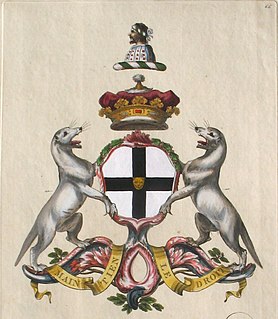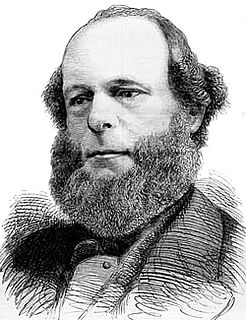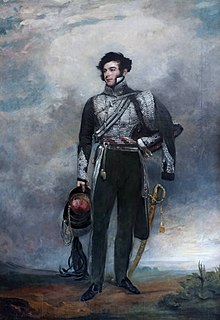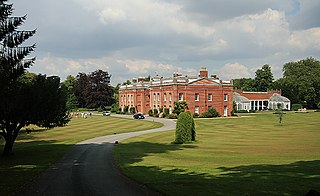Richard Plantagenet may refer to any Richard who was a descendant of Geoffrey Plantagenet, Count of Anjou:
Duke of Buckingham held with Duke of Chandos, referring to Buckingham, is a title that has been created several times in the peerages of England, Great Britain, and the United Kingdom. There have also been earls and marquesses of Buckingham.

Richard Temple-Nugent-Brydges-Chandos-Grenville, 1st Duke of Buckingham and Chandos, styled Earl Temple from 1784 to 1813 and known as The Marquess of Buckingham from 1813 to 1822, was a British landowner and politician.

Baron Lyttelton is a title that has been created twice in Peerage of Great Britain, both times for members of the Lyttelton family. Since 1889 the title has been a subsidiary title of the viscountcy of Cobham.

Viscount Cobham is a title in the Peerage of Great Britain that was created in 1718. Owing to its special remainder, the title has passed through several families. Since 1889, it has been held by members of the Lyttelton family.

Lord Kinloss is a title in the Peerage of Scotland. It was created in 1602 for Edward Bruce, later Master of the Rolls, with remainder to his heirs and assigns whatsoever. In 1604 he was also made Lord Bruce of Kinloss, with remainder to his heirs male, and in 1608 Lord Bruce of Kinloss, with remainder to any of his heirs. He was succeeded by his son, the second Lord, who was killed in a duel in 1613.

Earl Temple of Stowe, in the County of Buckingham, is a title in the Peerage of the United Kingdom. It was created in 1822 for Richard Temple-Nugent-Brydges-Chandos-Grenville, 2nd Marquess of Buckingham, who was created Marquess of Chandos and Duke of Buckingham and Chandos at the same time. In contrast to the Marquessate and Dukedom, which were created with remainder to the heirs male of his body only, the Earldom was created with remainder to (1) the heirs male of his body, failing which to (2) the heirs male of his deceased great-grandmother the 1st Countess Temple, failing which to (3) his granddaughter Lady Anna Grenville and the heirs male of her body, and then to possible younger daughters of Lord Temple and the heirs male of their bodies.

The Dukedom of Chandos is a title that has been created twice in the Peerage of England. First created as a barony by Edward III in 1337; its second creation in 1554 was due to the Brydge family's service to Mary I during Wyatt's Rebellion, when she also gifted them Sudeley Castle. The barony was elevated to a dukedom in 1719, and it finally fell into abeyance in 1789, after 452 years. Jane Austen was the great-grandniece of the first duke.
The Baronetcy of Temple, of Stowe, in the Baronetage of England, was created on 24 September 1611 for Thomas Temple, eldest son of John Temple of Stowe, Buckinghamshire. His great-grandson Sir Richard, 4th Baronet, was created Baron Cobham on 19 October 1714, and Viscount Cobham and Baron Cobham on 23 May 1718, the latter with a special remainder, failing his male issue to his sisters and their heirs male. Upon his death on 13 September 1749, the barony of 1714 became extinct, the viscountcy and barony of 1718 passed to his elder sister, and the baronetcy passed to his second cousin once removed William Temple, of Nash House, who became 5th Baronet. On the death of Sir William's nephew Sir Richard Temple, 7th Baronet, on 15 November 1786, the baronetcy became dormant.

Richard Plantagenet Campbell Temple-Nugent-Brydges-Chandos-Grenville, 3rd Duke of Buckingham and Chandos, styled Earl Temple until 1839 and Marquess of Chandos from 1839 to 1861, was a British soldier, politician and administrator of the 19th century. He was a close friend and subordinate of Benjamin Disraeli and served as the Secretary of State for the Colonies from 1867 to 1868 and Governor of Madras from 1875 to 1880.
Earl Nugent was a title the Peerage of Ireland. It was created on 21 July 1776 for Robert Craggs-Nugent, 1st Viscount Clare, with remainder, failing heirs male of his body, to his son-in-law The 3rd Earl Temple and the heirs male of his body. Craggs-Nugent had already been made Baron Nugent, of Carlanstown in the County of Westmeath, and Viscount Clare, in the Peerage of Ireland on 19 January 1767. He died 13 October 1788, when the barony and viscountcy became extinct, and the earldom, under the terms of the special remainder, passed to his son-in-law, formerly known as Lord Temple, now The 1st Marquess of Buckingham. The earldom remained in his family until the death of The 5th Earl Nugent, also The 3rd Duke of Buckingham and Chandos, on 26 March 1889. See Viscount Cobham for further history of the title. The barony of Nugent was revived in 1800 in favour of his daughter, Mary, Marchioness of Buckingham. See Baron Nugent.

Richard Plantagenet Temple-Nugent-Brydges-Chandos-Grenville, 2nd Duke of Buckingham and Chandos,, styled Viscount Cobham from birth until 1813, Earl Temple between 1813 and 1822 and Marquess of Chandos between 1822 and 1839, was a British Tory politician. He served as Lord Privy Seal between 1841 and 1842.
There has been a Lord Lieutenant of Buckinghamshire almost continuously since the position was created by King Henry VIII in 1535. The only exception to this was the English Civil War and English Interregnum between 1643 and 1660 when there was no king to support the Lieutenancy. The following list consists of all known holders of the position: earlier records have been lost and so a complete list is not possible. Since 1702, all Lord Lieutenants have also been Custos Rotulorum of Buckinghamshire.

Avington is a small village in the English county of Hampshire.
British history provides several opportunities for alternative claimants to the English and later British Crown to arise, and historical scholars have on occasion traced to present times the heirs of those alternative claims.
James Brydges, 3rd Duke of Chandos PC, styled Viscount Wilton from birth until 1744 and Marquess of Carnarvon from 1744 to 1771, was a British peer and politician.

Anna Maria Talbot, Countess of Shrewsbury was Countess of Shrewsbury from 1659 to 1668, by virtue of her marriage to Francis Talbot, 11th Earl of Shrewsbury.

The Bruges Garter Book is a 15th-century illuminated manuscript containing portraits of the founder knights of the Order of the Garter. It was made to the order of William Bruges, Garter King of Arms, and constitutes the first armorial covering members of the Order. It has been held since 1883 by the British Library in London under catalogue reference Stowe MS 594, indicating its former existence within the Library of the Dukes of Buckingham at Stowe House.

Hope Botanical Gardens, also known as the Royal Botanical Gardens, is a 200-acre (81 ha) park and gardens located in St Andrew, Jamaica.
Duchess of Buckingham is a title given to the wife of the Duke of Buckingham, an extinct title created several times, formerly in the Peerage of England and latterly in the Peerage of the United Kingdom. It was first created in 1444.













